Intel Xeon E-2174G Benchmarks
For this exercise, we are using our legacy Linux-Bench scripts which help us see cross-platform “least common denominator” results we have been using for years as well as several results from our updated Linux-Bench2 scripts. At this point, our benchmarking sessions take days to run, and we are generating well over a thousand data points. We are also running workloads for software companies that want to see how their software works on the latest hardware. As a result, this is a small sample of the data we are collecting and can share publicly. Our position is always that we are happy to provide some free data but we also have services to let companies run their own workloads in our lab, such as with our DemoEval service. What we do provide is an extremely controlled environment where we know every step is the same and each run is done in a real-world data center, not a test bench.
We are going to show off a few results, and highlight some interesting data points in this article.
Python Linux 4.4.2 Kernel Compile Benchmark
This is one of the most requested benchmarks for STH over the past few years. The task was simple, we have a standard configuration file, the Linux 4.4.2 kernel from kernel.org, and make the standard auto-generated configuration utilizing every thread in the system. We are expressing results in terms of compiles per hour to make the results easier to read:
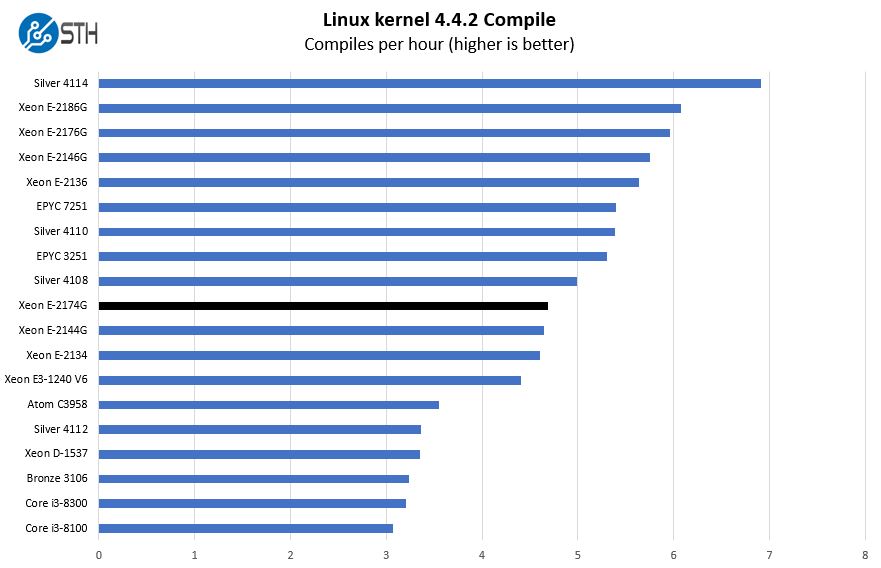
For a quad-core part, the Intel Xeon E-2174G is very fast. With its high clock speeds, it is just a bit slower than the Intel Xeon Silver 4108 8-core CPU.
c-ray 1.1 Performance
We have been using c-ray for our performance testing for years now. It is a ray tracing benchmark that is extremely popular to show differences in processors under multi-threaded workloads. We are going to use our 8K results which work well at this end of the performance spectrum.
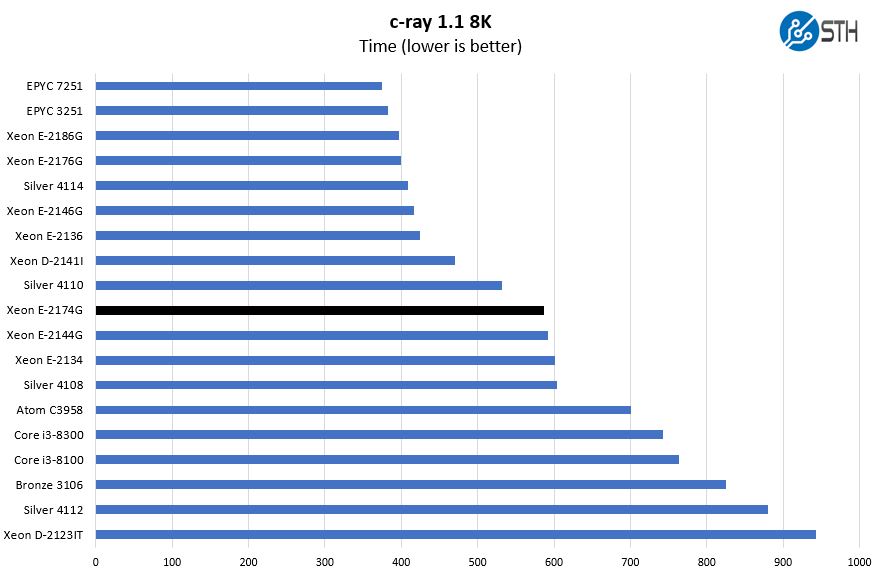
Again, high clock speeds help a lot here. On the other hand, we can see the higher core count parts pull away.
7-zip Compression Performance
7-zip is a widely used compression/ decompression program that works cross-platform. We started using the program during our early days with Windows testing. It is now part of Linux-Bench.
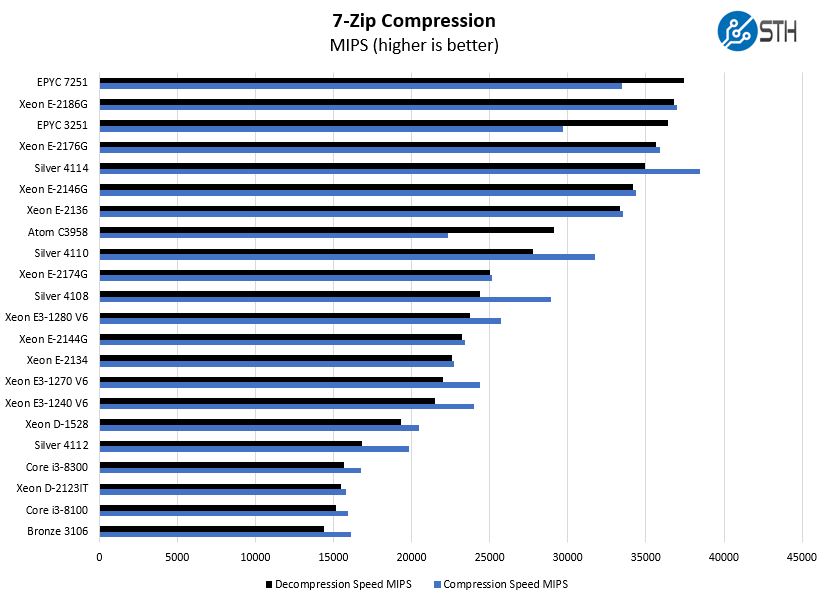
This is an excellent example of the generational improvements the new Intel Xeon E-2100 series offers over the previous generation Intel Xeon E3-1200 V6 CPUs that were limited to quad cores. Here, the Intel Xeon E-2174G outpaces the Intel Xeon E3-1280 V6 by a good margin in our decompression tests. The range on the compression/ decompression speed has also closed with this generation.
NAMD Performance
NAMD is a molecular modeling benchmark developed by the Theoretical and Computational Biophysics Group in the Beckman Institute for Advanced Science and Technology at the University of Illinois at Urbana-Champaign. More information on the benchmark can be found here. With GROMACS we have been working hard to support Intel’s Skylake AVX-512 and AVX2 supporting AMD Zen architecture. Here are the comparison results for the legacy data set:
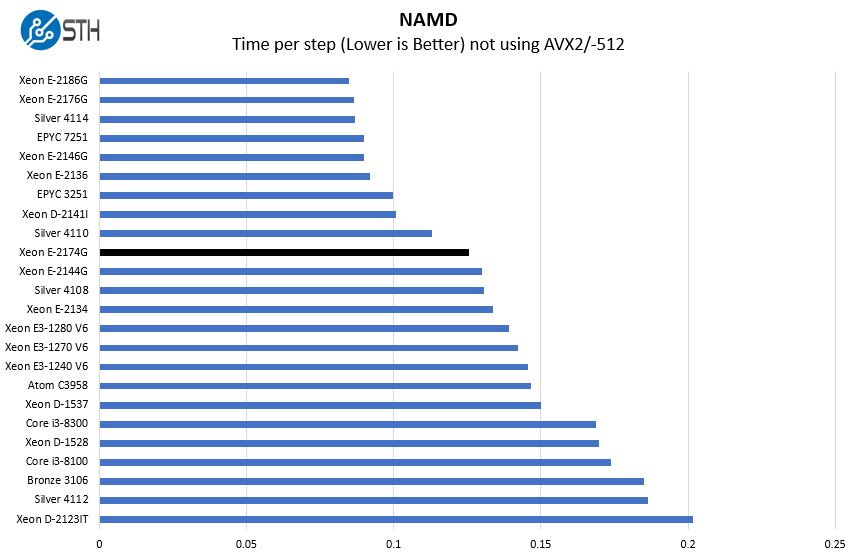
High clock speeds again hand the Intel Xeon E-2174G a victory over the previous generation Intel Xeon E3-1280 V6 quad core. You can read more about the evolution of this line of Intel CPUs in our piece: Looking back at Intel Xeon E3-1200 V1-V6 to the New Xeon E-2100.
Sysbench CPU test
Sysbench is another one of those widely used Linux benchmarks. We specifically are using the CPU test, not the OLTP test that we use for some storage testing.
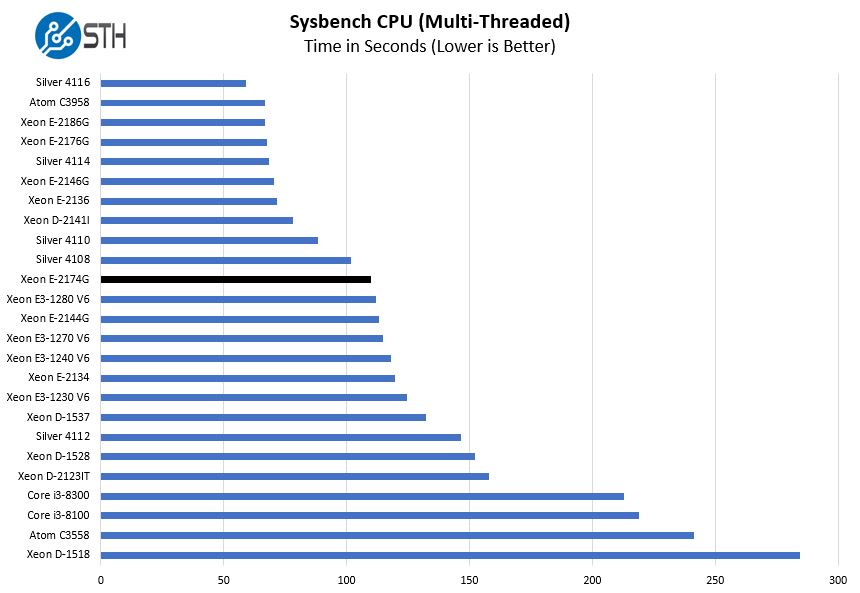
This is a test where we see great scaling with Hyper-Threading and higher clock speeds. Looking at the Intel Core i3-8100 and Core i3-8300, there is a significant performance gap, albeit with a significant price gap as well.
OpenSSL Performance
OpenSSL is widely used to secure communications between servers. This is an important protocol in many server stacks. We first look at our sign tests:
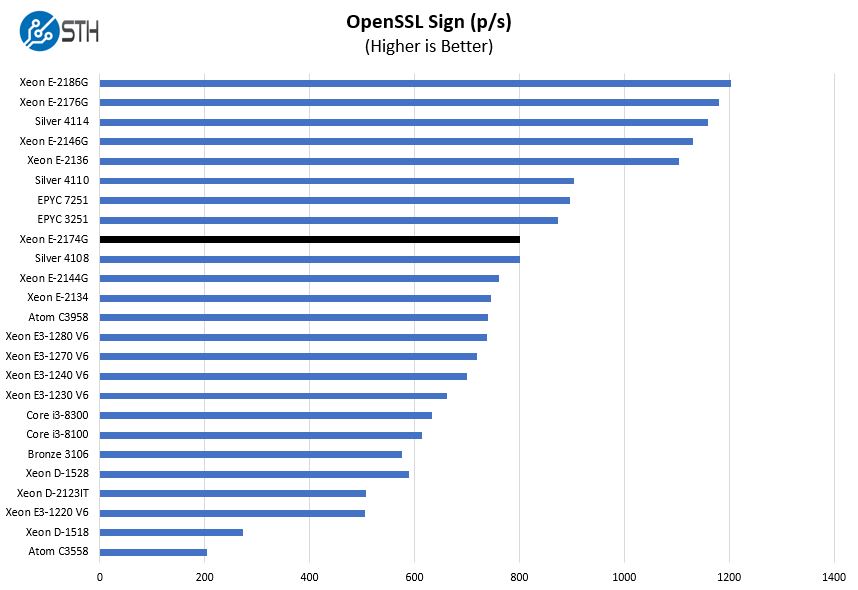
Here are the verify results:
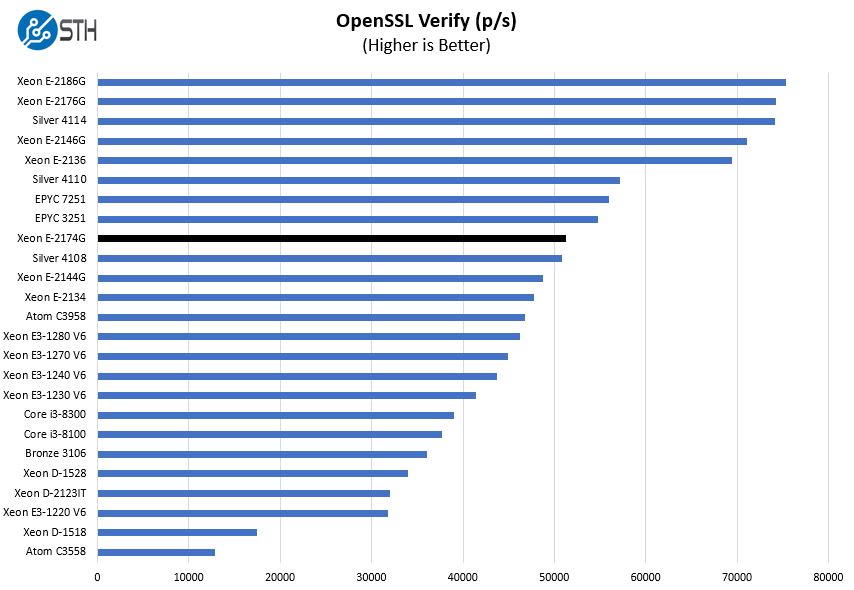
Here one can see very solid results, however, there is a catch. The Intel Xeon E-2176G is about $30-40 more and has a step function more performance given that it is a 6 core part.
UnixBench Dhrystone 2 and Whetstone Benchmarks
Some of the longest-running tests at STH are the venerable UnixBench 5.1.3 Dhrystone 2 and Whetstone results. They are certainly aging. However, we constantly get requests for them, and many angry notes when we leave them out. UnixBench is widely used, so we include it in this data set. Here are the Dhrystone 2 results:
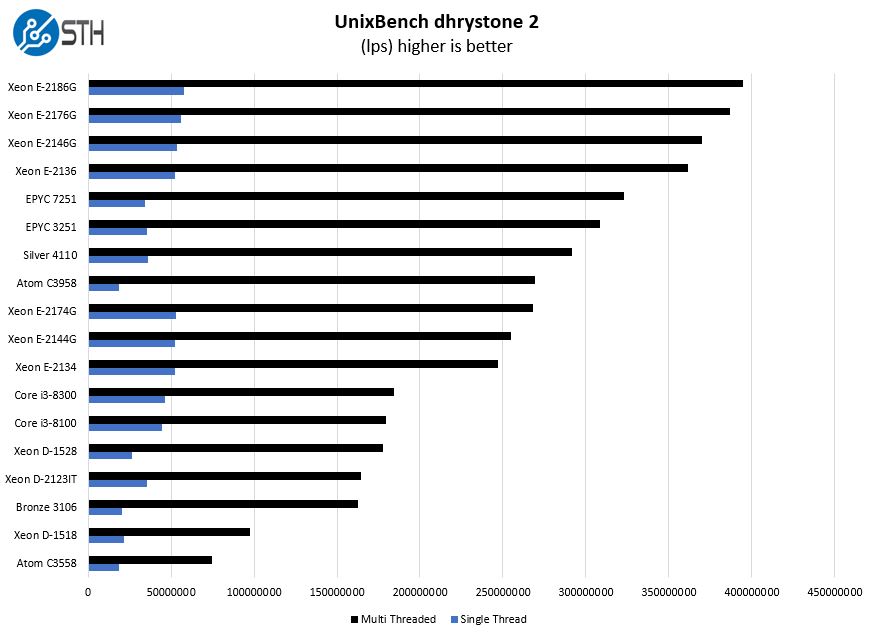
Here are the whetstone results:
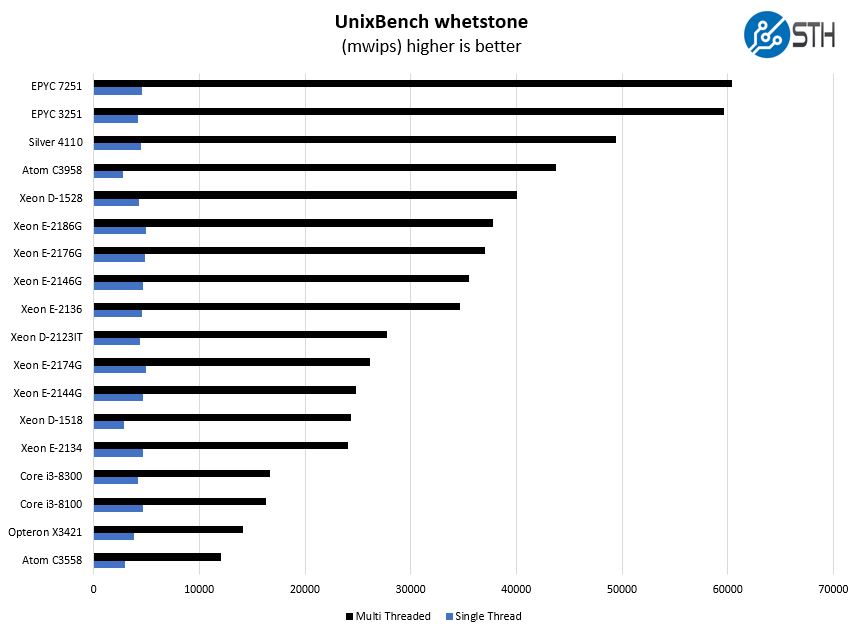
Our UnixBench results show a similar pattern. The Intel Xeon E-2174G is certainly a quick chip, but if you do not need the integrated GPU, the Intel Xeon E-2136 is $40-45 less expensive and faster in most cases.
GROMACS STH Small AVX2/ AVX-512 Enabled
We have a small GROMACS molecule simulation we previewed in the first AMD EPYC 7601 Linux benchmarks piece. In Linux-Bench2 we are using a “small” test for single and dual socket capable machines. Our medium test is more appropriate for higher-end dual and quad socket machines. Our GROMACS test will use the AVX-512 and AVX2 extensions if available.
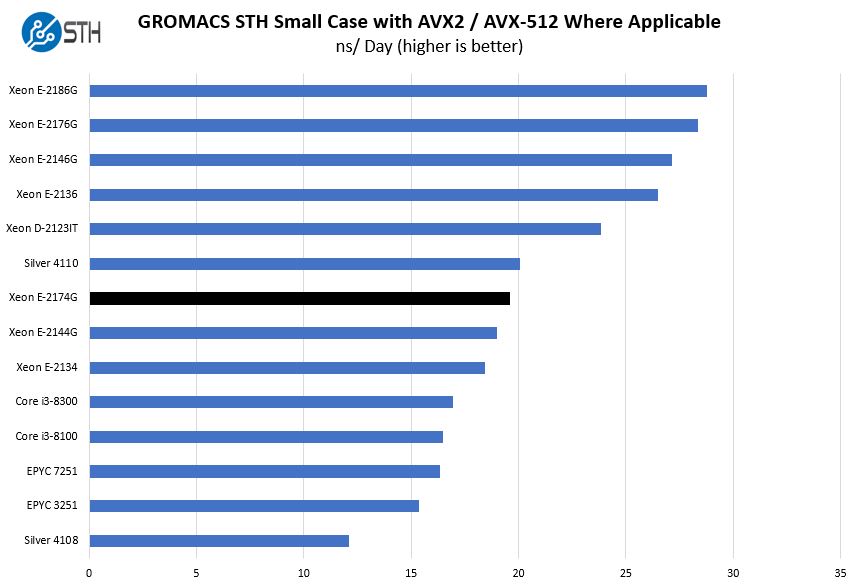
It is unlikely we will see GROMACS run on many of these CPUs, but we wanted to take advantage of the AVX2 pipeline. Here though, you would be better served with the Intel Xeon D-2123IT quad-core embedded part due to its AVX-512 performance.
Chess Benchmarking
Chess is an interesting use case since it has almost unlimited complexity. Over the years, we have received a number of requests to bring back chess benchmarking. We have been profiling systems and are ready to start sharing results:
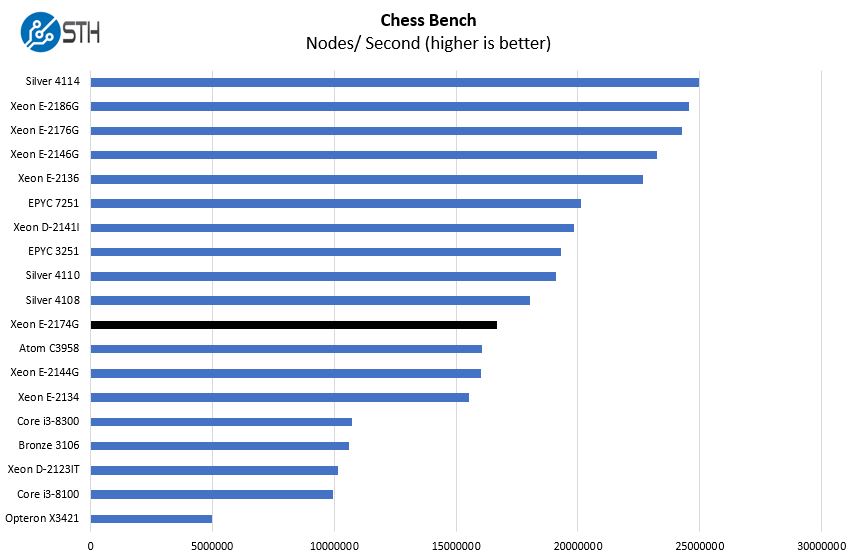
Here is where we start to see the limits of what high clock speeds can mask. Here, lower TDP Atom C3958 parts and parts with more than four cores dominate the benchmark.
Next, we are going to have the power consumption, market positioning, and our final words.




I’ve been looking at getting an E-2100 for my homelab, but right now these CPUs still seem to be missing from the retail channel. The entry line provides a lot of value for the price. You can opt to fill in one or two of the platform gaps like 10G networking or storage via PCIe and make a strong case against both C3000 and D-2100. Unless the higher memory capacity is a sticking point, the value dollar probably goes with the E-2100 platform.
You need better, or some, proofreading of this article as there are many errors.
It’ll be game changer when AMD makes a full push with ECC memory.
AMD should enter into this niche of Xeon E and Xeon W. Could it be possible to encapsulate an Epyc of 6 or 8 cores in an AM4 socket? It would be unbeatable in price and performance.
> “Intel specs say that as 32GB ECC UDIMM modules become available, the CPUs will support 128GB in 4x32GB configurations.”
Status: Sample
2933 Mbps: https://www.samsung.com/semiconductor/dram/module/M391A4G43AB1-CVF/
2666 Mbps: https://www.samsung.com/semiconductor/dram/module/M391A4G43MB1-CTD/